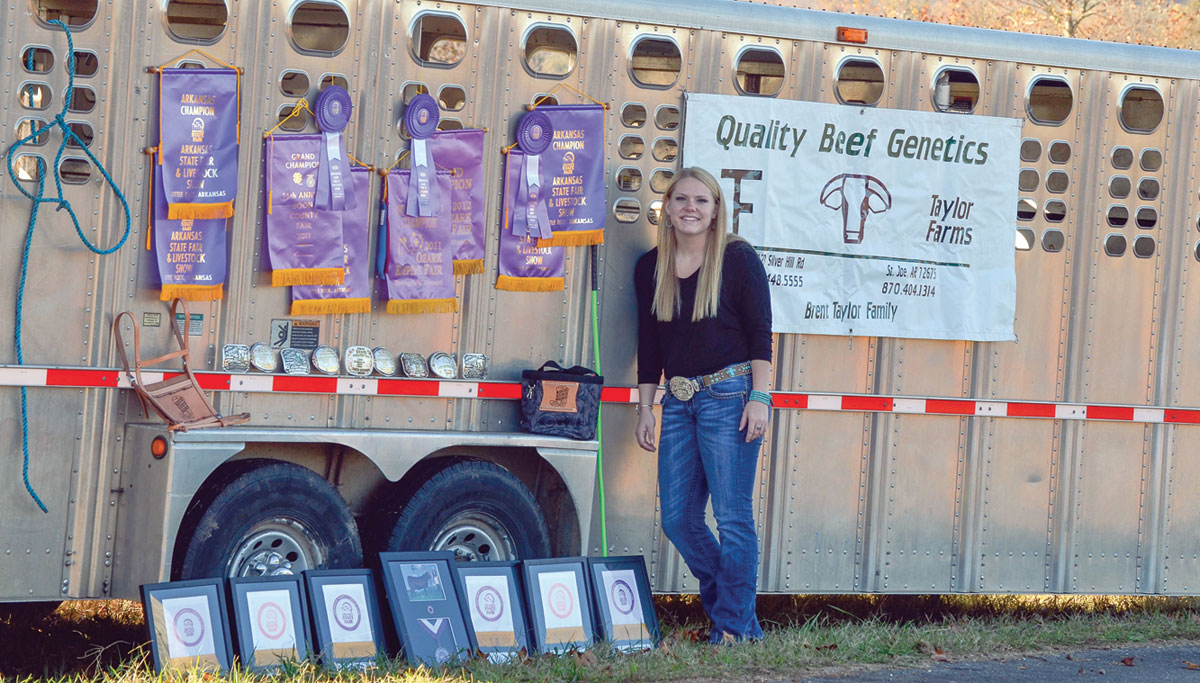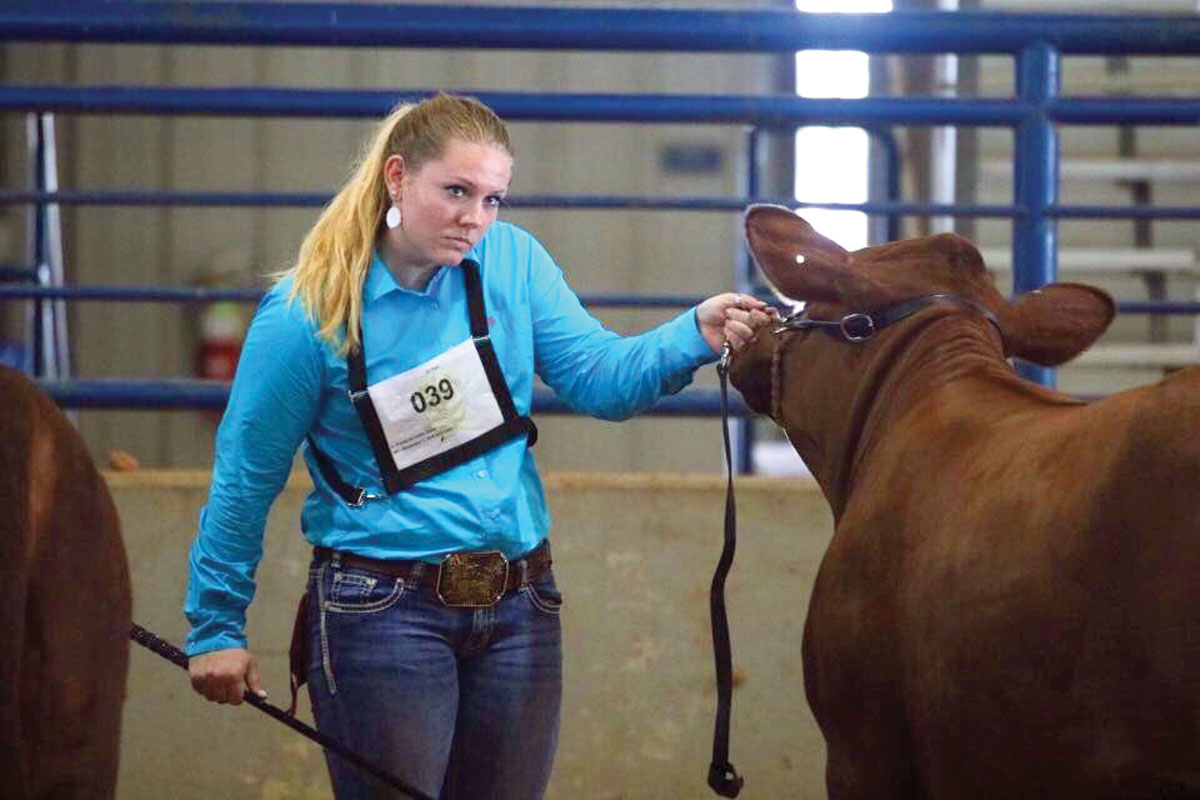
Emmalee Taylor is a fifth-generation rancher and plans to expand her own herd
Ever since she can remember, Emmalee Taylor has enjoyed being around cattle and life on her family’s Arkansas ranch.
“I like dealing with cattle better than people; they don’t talk back to you,” she said with a laugh. “I tell people I don’t know who I would be, what I would be doing or what kind of trouble I would have been without being out working with cattle… To me, raising cattle, farming and agriculture have a lot of tradition, and you get to contribute something that can affect so many people, whether they are in agriculture or not; you’re getting to contribute to society and make the world a better place. I joked with my mom that if I didn’t go to college to get a ‘real world job,’ I’d just stay home with the cows all day.”
Emmalee, the 20-year-old daughter of Brent and Robin Taylor, grew up on a nearly 1,000-acre beef cattle ranch in Silver Hill, Ark., which is home to about 250 head of purebred Santa Gertrudis, Angus and Red Angus.
Following in her family’s footsteps, Emmalee, a fifth-generation rancher, has a growing herd of Santa Gertrudis herself. Her father and grandfather, Duford Taylor, moved from commercial cattle to Santa Gertrudis in the 1980s after raising commercial cattle.
Emmalee has shown her cattle at the local, state and national level since she was a youngster, and attended her first junior national Santa Gertrudis show when she was 2 years old. Emmalee admits she doesn’t remember anything about the show, where her older sister Westin exhibited, but she’s been to 18 shows since then.
“Showing cattle has introduced me to some wonderful people and built some great relationships that I will have all of my life,” she said. “It’s been a great networking opportunity to be around like-minded people who are working toward the same goal that you are. At junior nationals, there are various competitions, like judging, prepared public speaking and tool identification. Personally, I have always liked the public speaking aspect and it has really helped me as far as my commutative skills and being able to talk to people. It’s really helped me be more confident in what I do.”
When asked about her competitions, be it in the show ring or in other areas, Emmalee humbly responded, “We’ve had some success.”
“Everyone wants to win, but for us, we took pride in having animals we bred from our genetics experience success,” she said. “That’s where we’ve taken the most pride.”
The young cattlewoman is a true advocate of the Santa Gertrudis breed and enjoys sharing information about deep-red, deep-bodied, well-muscled breed.
“We’re America’s first beef breed,” she said. “We are a purebred breed 3/8 Brahman and 5/8 Shorthorn, and the breed got started in Kingsville, Texas. I actually run into a lot of bias against American cattle because people want to pick them apart. I guess I’ve always been for the underdog and I like to like the things other people don’t. We’ve really put a lot of focus on genetics and are really picky about the way we breed, and we’re implementing that into our commercial herd as well.
“We’ve seen some increased interest from people who want to buy purebred Santa Gertrudis bulls from us rather than a commercial cross, and so I think that’s an area we can expand on. It’s really delighted us to spread our genetics to people who really have an interest in the breed.”
While a Santa Gertrudis breeder at heart, Emmalee has added another red breed to her herd – Red Charolais.
“That kind of happened by accident,” she said. “Larry Julian from around Crane, Mo., got in touch with me because he was looking to implement some Red Charolais into a younger generation. He asked me if I would take some embryos and partner up and see what came of it.”
Emmalee took out a youth loan and implanted five heifer embryos and a single bull embryo into their Santa Gertrudis/Angus recip cows. So far Emmalle has been pleased with the results.
“They are some of the fastest growing calves we’ve ever seen,” she said. “They are growthy and productive cattle. I’ve been really pleased and they are something really interesting. People hear Charolais and they think of white cattle; it’s just really been a cool thing to play around with. My grandpa delights when people stop by to chat and he tells them, ‘let’s get in the truck because I want you to see my granddaughter’s Red Charolais; these are some of the best cattle going.’ He really likes to show them to anyone who wants to see them. It’s really served us well and we are really pleased with how it’s going.”
The genetics of the cattle business intrigue Emmalee and she credits her dad, Brent, for her interest.
“He’s really worked to modify our farm genetics to exceed our breed standard within the Santa Gertrudis breed,” she said. “What he likes to say is that you have to grow and keep the kind of cattle you like, first and foremost. Then you have to think about your customer base because you have to provide cattle to them and what they are looking for. We want to use our genetics and produce what we’re happy with at the end of the day.”
Emmalee has about a 25-head herd and has plans for future growth.
“I’d like to have a sizable herd like my grandpa and dad one day,” she said. “I want to keep an eye on the shifts in the cattle industry and how I need to alter my genetics, to not only keep producing what I want to produce, but to meet consumer needs as well.”
Emmalee is currently a junior at Arkansas Tech University in Russellville, Ark., where she is majoring in ag business with an emphasis in animal science, and she is considering seeking a master’s degree.
“I really haven’t narrowed down what I want to do as far as a specific job, but I always want to have that involvement in agriculture,” Emmalee said. “I feel blessed to be born into a family involved in agriculture and the cattle industry. This is what I want to be doing.”







